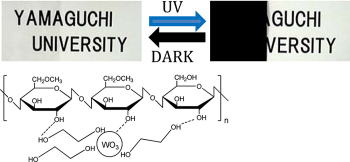論文がアクセプトされました(山崎先生・安達先生 共著)
Photochromic Properties of Tungsten Oxide/Methylcellulose Composite Film
Containing Dispersing Agents
S. Yamazaki, H. Ishida, D. Shimizu, K. Adachi
ACS Appl. Mater. Interfaces, 2015, 7, 26326–26332.
DOI : 10.1021/acsami.5b09310
Abstract: Tungsten oxide-based photochromic films which changed reversibly in air between colorless– transparent in the dark and dark blue under UV irradiation were prepared by using methylcellulose as a film matrix and polyols such as ethylene glycol (EG), propylene glycol (PG), and glycerin (Gly) as dispersing agents. Influence of the dispersing agents and water in the films on the photochromic behavior was systematically studied. Under UV irradiation, absorption bands around 640 and 980 nm increased and the coloring rate was the following order: Gly > EG > PG. An increase in the amounts of dispersing agents or water accelerated the coloring rate. By increasing the water content of the film, a new absorption peak appeared at ca. 775 nm and the Raman spectra indicated a shift of W–O–W stretching vibration to lower wavenumber which was due to the formation of hydrogen bonding. All absorption spectra were fit by three Lorentz functions, whose bands were ascribed to various packing of WO6 octahedra. After the light was turned off, the formation of W5+ was stopped and bleaching occurred by the reaction with O2 in air to recover its original transparent state. We anticipate that the biodegradable photochromic films developed in this study can be applied in recyclable display medium and especially in detachable films for glass windows whose light transmission properties are changed by sunlight, i.e., for usage as an alternative of smart windows without applying voltage.
